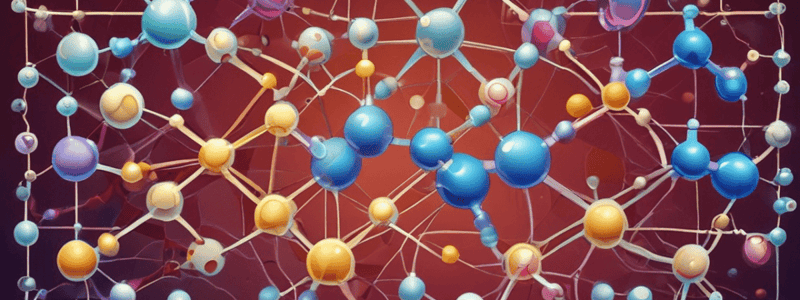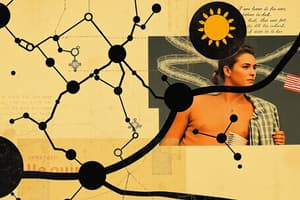Podcast
Questions and Answers
What is the characteristic of monosodium urate crystals in synovial fluid analysis?
What is the characteristic of monosodium urate crystals in synovial fluid analysis?
- Birefringent, needle-shaped (correct)
- Non-birefringent, cuboidal
- Negative
- Positive
What is the typical cell count in normal synovial fluid?
What is the typical cell count in normal synovial fluid?
- Lots of RBCs
- > 50,000/uL
- > 2000/uL
- < 200/ul (correct)
What is the primary mechanism of action of colchicine?
What is the primary mechanism of action of colchicine?
- Reducing inflammation through analgesics
- Inhibiting uric acid production
- Binding tubulin and preventing microtubule polymerization (correct)
- Increasing uric acid excretion
What is the typical treatment for gout?
What is the typical treatment for gout?
What is the characteristic of calcium pyrophosphate crystals in synovial fluid analysis?
What is the characteristic of calcium pyrophosphate crystals in synovial fluid analysis?
What is the adverse effect of colchicine that is related to its mechanism of action?
What is the adverse effect of colchicine that is related to its mechanism of action?
What is the typical cell count in septic arthritis synovial fluid?
What is the typical cell count in septic arthritis synovial fluid?
What is the therapeutic use of colchicine in gout?
What is the therapeutic use of colchicine in gout?
What is the characteristic of hemarthrosis synovial fluid?
What is the characteristic of hemarthrosis synovial fluid?
What is the purpose of uricosurics in gout treatment?
What is the purpose of uricosurics in gout treatment?
Flashcards are hidden until you start studying
Study Notes
Nucleic Acids
- Nucleosides consist of a sugar molecule and a nitrogenous base
- The sugar molecule can be either ribose (RNA) or deoxyribose (DNA)
- The nitrogenous base can be either a pyrimidine (C, U, T) or a purine (A, G)
Nucleotide Bases
- Pyrimidine bases: cytosine (C), uracil (U), thymine (T)
- Purine bases: adenine (A), guanine (G)
- Note: "ine" ending is used for DNA bases, while "dine" ending is used for nucleosides
Purine Biosynthesis
- There are two main pathways: de novo synthesis and the salvage pathway
- De novo synthesis involves the creation of purine nucleotides from basic building blocks
- The salvage pathway recycles free purine bases back into nucleotides
- Glutamine is used in the de novo synthesis pathway
Purine De Novo Synthesis
- IMP can be used to make AMP or GMP
- GTP is used to make AMP, while ATP is used to make GMP
- This reciprocal control allows for regulation of purine nucleotide production
Purine Salvage Pathway
- Important to conserve energy, as de novo synthesis uses a lot of energy
- Free purine bases (adenine, guanine, hypoxanthine) are recycled back into nucleotides
- Key enzymes involved: adenine phosphoribosyltransferase (APRT) and hypoxanthine-guanine phosphoribosyltransferase (HGPRT)
Pyrimidine Nucleotide Synthesis
- The pyrimidine ring is formed first, followed by the attachment of a ribose-5-phosphate to form the nucleotide
- Key pyrimidine nucleotides synthesized: cytosine, thymine (in DNA), and uracil (in RNA)
- Glutamine, ATP, and HCO3- are used in the synthesis pathway
Pyrimidine Nucleotide Synthesis Steps
- Formation of carbamoyl phosphate
- Formation of carbamoyl aspartate
- Cyclization of dihydroorotate
- Oxidation to orotate
- Formation of orotidine monophosphate (OMP)
- Decarboxylation to UMP
- Conversion to other pyrimidine nucleotides
- Synthesis of thymidine nucleotides
Synovial Fluid Analysis
- Done to diagnose infectious arthritis, flare of crystal arthritis, or hemarthrosis
- Analyze the three C's: crystals, cells, and culture
- Crystals: seen under microscopy with gout and pseudogout
- Cells: red blood cells, leukocytes (neutrophils or lymphocytes)
- Culture: any microorganisms growing in the fluid
Synovial Fluid Analysis Results
- Normal: < 200/ul cells, negative crystals, negative culture
- Gout: > 2000/uL cells, birefringent needle-shaped crystals, negative culture
- Pseudogout: > 2000/uL cells, non-birefringent cuboidal crystals, negative culture
- Septic arthritis: > 50,000/uL cells, negative crystals, positive culture
- Hemarthrosis: lots of RBCs, negative crystals, negative culture
- Inflammatory arthritis: > 2000/uL cells, negative crystals, negative culture
- Osteoarthritis: < 2000/uL cells, negative crystals, negative culture
Anti-gout Agents
- Targeting inflammation: corticosteroids, colchicine
- Analgesics: NSAIDs (e.g. aspirin)
- Decreasing uric acid production: allopurinol
- Increasing uric acid excretion: uricosurics (e.g. probenecid and sulfinpyrazone)
Colchicine
- Mechanism of action: binds tubulin and prevents microtubule polymerization
- Effect on inflammation: reduces inflammation by preventing neutrophil migration
- Used to treat gout, also considered for treating cancer and familial Mediterranean fever
- Adverse effects: bone marrow depression, diarrhea, nausea
Studying That Suits You
Use AI to generate personalized quizzes and flashcards to suit your learning preferences.




